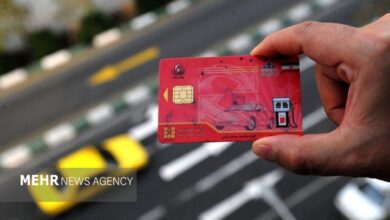-
آخرین اخبار

معرفی بهترین محصولات مراقبت از پوست برای حفظ زیبایی و سلامت
برخورداری از پوستی سالم و باطراوت خواسته بسیاری از افراد است. امروزه گوناگونی محصولات مراقبتی این فرصت را فراهم میکند…
بیشتر بخوانید » -
آخرین اخبار

چرا تور چابهار انتخابی هوشمندانه برای سفر زمستانی است؟
چابهار یکی از معدود مقاصد گردشگری ایران است که در فصل زمستان نه تنها سرد نمی شود، بلکه به یکی…
بیشتر بخوانید » -
آخرین اخبار

راهنمای جامع دریافت ویزای انگلیس: از انواع ویزا تا مراحل موفقیت در پرونده
انگلستان همواره یکی از مقاصد اصلی برای گردشگران، دانشجویان و متخصصان سراسر جهان بوده است. با وجود قوانین دقیق مهاجرتی،…
بیشتر بخوانید » -
آخرین اخبار

اگر ماشین داغ کرد چه کنیم
یکی از مشکلات رایجی که ممکن است هر رانندهای در طول مسیر با آن مواجه شود، داغ کردن خودرو است.…
بیشتر بخوانید » -
آخرین اخبار

آیا میشود با سرمایه کم وارد آمارکتس شد؟ حداقل واریزی چقدر است؟
اولین باری که اسم آمارکتس به گوشم خورد، چیزی که توجهم رو جلب کرد حداقل واریز کم بود. راستش رو…
بیشتر بخوانید » -
امداد خودرو کیا در تهران؛ تعمیرات تخصصی اپتیما، اسپورتیج و سراتو در محل
خودروهای کمپانی کیا (KIA) به دلیل استهلاک پایین و شتاب خوب، از محبوبترین خودروها در خیابانهای تهران هستند. اما ترافیک…
بیشتر بخوانید » -
آخرین اخبار

10 ایده نقاشی ساده برای تمرین روزانه
یکی از بهترین روشها برای پیشرفت در نقاشی، تمرین روزانه است. لازم نیست هر دفعه یک اثر پیچیده و سخت…
بیشتر بخوانید » -

نرخ سوم بنزین اعلام شد؛ سوختگیری با کارت سوخت جایگاه لیتری ۵۰۰۰ تومان
به گزارش خبرنگار مهر با مصوبه هیئت وزیران، نرخ بنزین جایگاه با استفاده از کارت اضطراری برای مصرف مازاد ۱۶۰…
بیشتر بخوانید » -
چالش کمبود نیروی متخصص در آلمان: روندهای کنونی و استراتژیهای شرکتها
اقتصاد آلمان، که همچنان یکی از ستونهای اصلی اروپا به شمار میرود، در سالهای اخیر با مجموعهای از چالشهای ساختاری…
بیشتر بخوانید » -
انتخاب آگاهانه با همراهی آبان سرفیس
وقتی تجهیزات کاری یا آموزشی شما باید هم سبک باشد و هم قابلاتکا، شناخت درست محصول و فروشنده اهمیت پیدا…
بیشتر بخوانید » -
آخرین اخبار

انتصاب مهم در دولت؛ اسماعیل سقاب به معاونت انرژی رسید
🔹 انتصاب مهم در دولت؛ اسماعیل سقاب به معاونت انرژی رسید دکتر اسماعیل سقاب با حکم رئیسجمهور به عنوان معاون…
بیشتر بخوانید » -
استرس «ماشین توقیف شده»؛ وقتی خلافی پرداخت نشده زندگی روزمره را مختل میکند
هیچچیز به اندازه خبر توقیف خودرو به خاطر خلافیهای پرداختنشده، زندگی روزمره را دچار استرس نمیکند. هزینه پارکینگ، جرثقیل و…
بیشتر بخوانید » -

ایران در جمع ۳ کشور برتر تولیدکننده پسته جهان
به گزارش خبرنگار مهر، فرید تمهیدی همزمان با شامگاه سه شنبه در مراسم افتتاحیه جشنواره پسته دامغان در سالن همایشهای…
بیشتر بخوانید » -

اونس طلا به کانال ۳ هزار دلاری سقوط کرد؛ افت قیمت در کمین طلای داخلی
به گزارش خبرنگار مهر، قیمت جهانی طلا در شامگاه دوشنبه و در ساعات پایانی معاملات امروز با افت بیش از…
بیشتر بخوانید » -

اتصال ۱۰۵ مگاوات انرژی خورشیدی استان سمنان به شبکه سراسری برق
به گزارش خبرنگار مهر، محمد جواد کولیوند شامگاه یکشنبه در نشست بررسی مشکلات واحدهای صنعتی مستقر در شهرک صنعتی گرمسار…
بیشتر بخوانید » -

دیدار مدیرعامل بانک شهر با رئیس دانشگاه علوم پزشکی شهید بهشتی
به گزارش خبرگزاری مهر به نقل از روابط عمومی بانک شهر، در راستای توسعه تعاملات میان شبکه بانکی کشور و…
بیشتر بخوانید » -

بودجه ۱۴۰۵ بر اساس قانون یکم دی ماه به مجلس تقدیم میشود
به گزارش خبرگزاری مهر، محسن زنگنه درباره چرایی بررسی نحوه تنظیم بودجه سنواتی در کمیسیون برنامه و بودجه گفت: با…
بیشتر بخوانید » -

بهسازی خطوط ریلی در دستور کار تهران و اسلام آباد است
به گزارش خبرگزاری مهر به نقل از پایگاه اطلاع رسانی دولت: وزیر راه و شهرسازی در حاشیه اجلاس منطقهای حملونقل،…
بیشتر بخوانید » -

بازار ارز تجاری مرکز مبادله ایران ۱۶.۴ میلیارد دلاری شد
به گزارش خبرگزاری مهر، با معامله ۱۰۷.۵ میلیون دلار انواع ارز از سوی بازرگانان در روز سهشنبه ۲۹ مهرماه، حجم…
بیشتر بخوانید » -

وزیر نفت عازم قطر شد
به گزارش خبرگزاری مهر به نقل از پایگاه اطلاع رسانی دولت، محسن پاکنژاد، وزیر نفت کشورمان شامگاه سهشنبه (۲۹ مهر)…
بیشتر بخوانید »